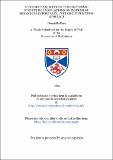Files in this item
A theoretical method for electronic structure calculations on systems of biological importance - the group function approach
Item metadata
| dc.contributor.advisor | Thomson, Colin | |
| dc.contributor.author | Paci, Donatella | |
| dc.coverage.spatial | 138 p. | en_US |
| dc.date.accessioned | 2018-07-16T15:14:19Z | |
| dc.date.available | 2018-07-16T15:14:19Z | |
| dc.date.issued | 1994 | |
| dc.identifier.uri | https://hdl.handle.net/10023/15439 | |
| dc.description.abstract | Theoretical methods for studying molecules of biological importance are reviewed, both ab initio and semi-empirical. The Group Function Approach is developed in detail in its strong orthogonal form and corrections to the energy are added for taking into account non-orthogonality effects, depending on the overlaps of the group functions. Approximations are introduced and tested so that this method can be applied to large molecules. In particular, a system (or a relevant fragment of it) is built up from localized two-electron groups, each one described by a two-electron group function (geminal). Each group function is optimized by using an SCF method with an effective hamiltonian consisting of the two-electron hamiltonian of the group together with the effective potential due to the presence of the other electron groups (and to the external environment, eventually). The wavefunction for the whole molecule is an antisymmetrized product of geminals. The energy is computed as a sum of group contributions. Corrections, depending on up to the second power of the overlaps of two groups at a time, are particularly important in conformational studies. The approximations introduced are based on the consideration that distant groups consisting of two positive and two negative charges see each other as neutral entities and thus do not contribute appreciably in the definition of the effective hamiltonian: the computing effort is greatly reduced in this way, the error introduced is small and can be estimated easily. The theoretical method presented in this thesis offers a powerful tool for making qualitative predictions of the changes resulting from localized effects, such as twisting around a bond, and it can be usefully applied to conformational studies and geometry optimizations. The other properties which can be calculated axe for the most part directly related to the electron density; this determines, for example, the electrostatic potential outside a molecule and hence the position of attack by approaching ions or polar species. Chemical reactions, which involve breaking or re-arrangement of bonds, provide another vast field of application. Such processes usually involve only localized regions in a molecule and the admission of intragroup CI ensures that the study of bond breaking remains valid throughout the whole process. All necessary computer programmes have been developed and numerical applications have been made to a range of molecules, including hydrocarbons, small molecules containing double bonds and lone pairs, and the amino acid glycine. | en_US |
| dc.language.iso | en | en_US |
| dc.publisher | University of St Andrews | |
| dc.subject.lcc | QD461.P2 | |
| dc.subject.lcsh | Molecular structure | en |
| dc.title | A theoretical method for electronic structure calculations on systems of biological importance - the group function approach | en_US |
| dc.type | Thesis | en_US |
| dc.type.qualificationlevel | Doctoral | en_US |
| dc.type.qualificationname | PhD Doctor of Philosophy | en_US |
| dc.publisher.institution | The University of St Andrews | en_US |
This item appears in the following Collection(s)
Items in the St Andrews Research Repository are protected by copyright, with all rights reserved, unless otherwise indicated.

